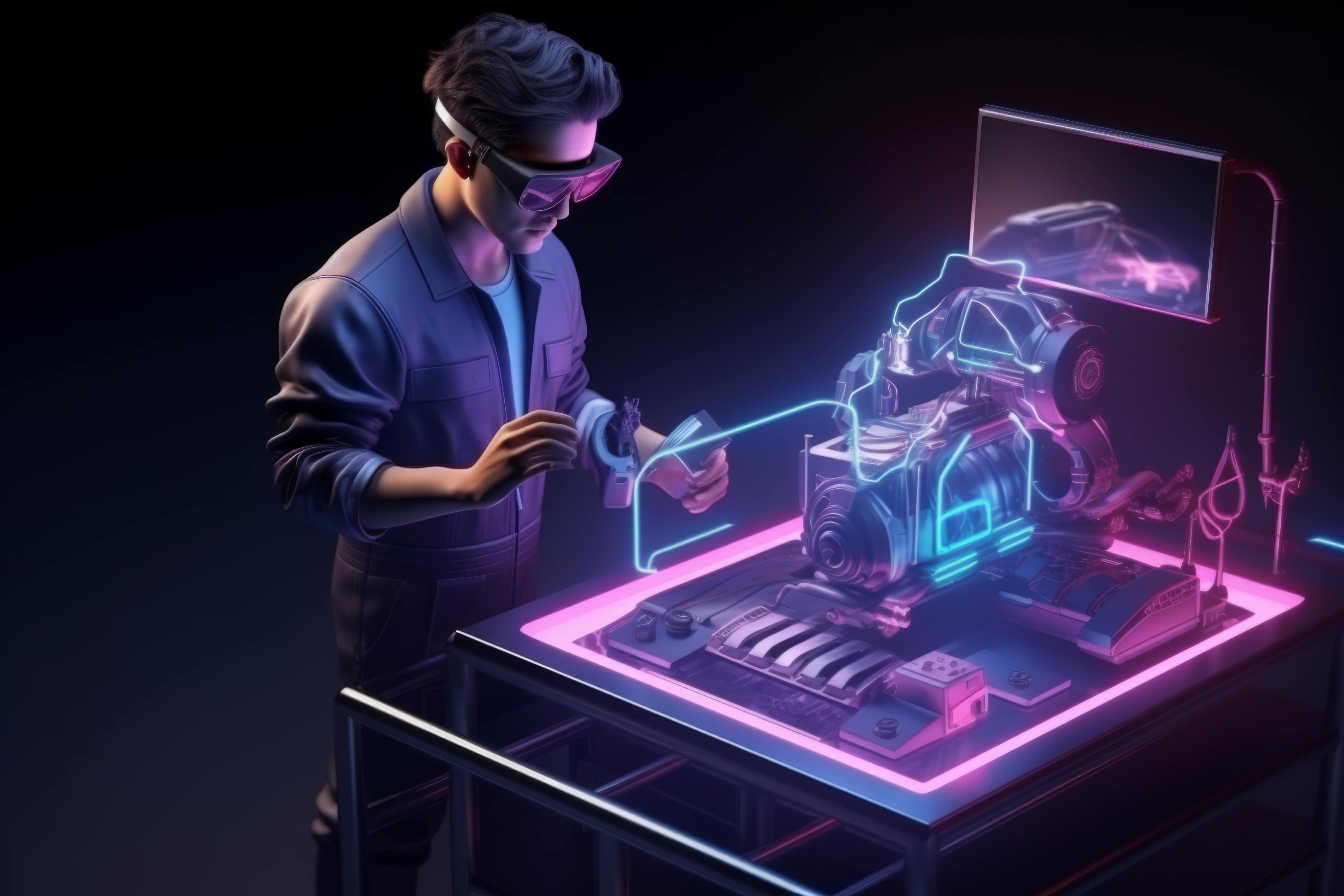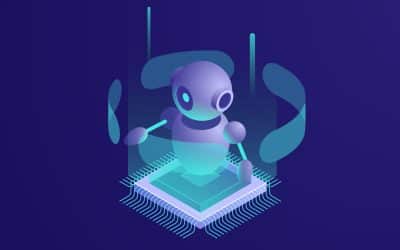One of the most fascinating technologies in the last decade since the mobile & cloud revolution is being used to create waves all over the globe is Gen AI. It has already proven the ability to perform things that humans require weeks or even days, from generating content to making complete web-based apps. It has much potential; however, the GenAI coin has challenges. Companies that employ Generative AI Development Services in a way that is not appropriate will find themselves in danger because the technology is uncertain. Threats want to take advantage of the technology. It’s safe to think that most business decision-makers will likely be between their hopes and fears about the rapidly changing technology. They’re curious about what it can do to transform their company more favorably, yet they think about whether it could be an employer-killer, which many employees are afraid of.
Therefore, when implementing an algorithm that generates AI, you should be careful and take the time to be aware of the dangers. In a time when everyone wants to create or use the most advanced technology available today, the most important thing to successful implementation is ensuring that it won’t unexpectedly impact your business. Like other technological advances, AI has advantages and disadvantages, as well as questions and issues, both for those who could benefit from it and those who use the technology to harm. Here’s a list of important AI capabilities and incapabilities for everyone to understand.
What Exactly Is Generative AI?
Generative AI, also known as Gen AI, is an artificial intelligence (AI) capable of creating new content, such as text videos, images, or code for software, in the wake of a user’s request or demand. Generative AI utilizes sophisticated machine learning algorithms known as deep learning models. These algorithms simulate the decision-making and learning processes that the brain uses to make decisions. They work by detecting and decoding patterns and relationships in large quantities of data and applying that data to analyze people’s natural language demands or inquiries and then respond with relevant content.
AI has been the hottest technology subject for the past decade. However, the advent of generative AI, particularly the introduction of ChatGPT in 2022, has pushed AI to the forefront of global news and spurred an unprecedented surge in AI advancement and acceptance. Generative AI can bring enormous efficiency benefits to individuals and companies but poses risks and challenges. Companies are advancing and exploring ways AI can enhance their processes within the company and enhance the quality of their services and products.
How Does Generative AI Work?
Generative AI uses a method known as deep learning to identify patterns within large amounts of data. It then reproduces these patterns to produce new human-generated data. This is accomplished by using neural networks. The neural networks are an ML process that resembles how the brain processes, interprets, and develops knowledge from data over long periods. For instance, If you add much writing from fiction into a generative model, it eventually gains the capability to create tales or elements of stories based on the works that it was trained in.
This is due to the algorithms for machine learning, which are the basis of the generative AI models that learn from the data they’re fed. In the instance of fiction, that could include things like plot structures, characters, themes, and other plot devices. Generative AI models become more advanced with time. The more information a model has created and trained upon it, the more authentic and believable the results it generates.
The Benefits Of Generative AI
As Gen AI generates content and answers questions upon demand, it can speed up or even automate tasks that require much labor. This reduces expenses and frees up employees’ time to do more profitable tasks. Yet Generative AI Applications also provide a variety of other advantages to individuals and organizations.
Creativity Boosted
Gen AI tools can inspire creativity through automated brainstorming, generating multiple novel versions of content. The variations could also be used as references or starting points, which helps writers, artists, designers, and others overcome creative blocks.
More Efficient Decision-Making
Generative AI excels in analyzing massive databases, finding patterns, uncovering valuable information, and formulating hypotheses and suggestions using those insights. These recommendations assist executives, analysts, scientists, and other professionals make better, more informed decisions based on data.
Dynamic Personalization
Generative AI will analyze users’ preferences and history and create real-time personalized content. This results in a better personalized and enjoyable user experience for recommendation systems and content creation applications.
Constant Availability
Generative AI runs nonstop, ensuring 24/7 accessibility for jobs such as chatbots for customer support and automated response.
Important Considerations To Make When Designing A Generative AI
Although it is powerful when used for an intended purpose, it has some limitations that users should be aware of. It creates a sense of reality that isn’t real. It is susceptible to injection attacks that prompt it, which criminals can use to their advantage. There are many various outputs with identical inputs. Using it unwisely in an enterprise context could result in problems with compliance and legal.
We will look at some guidelines on GenAI development provided by professionals:
- More than good data from third parties and good outputs are needed. Companies must also try to use the information they acquire in person and the information their clients proactively share with them.
- Models that are being trained should be carefully selected to guarantee safety and accuracy.
- Human supervision is required even when well-trained and using quality information.
- GenAI isn’t a plug-and-play technology you can implement and then forget about. It must be checked to ensure proper functioning because the model’s efficiency can fluctuate over time.
- Utilize your community, team, and others to get the most feedback possible to improve the effectiveness of your GenAI implementation.
These guidelines can help you avoid applying generative AI when it cannot add any value at this point.
Things AI Can Do In 2024
AI has been generating much more attention recently for excellent reasons. Below are a few of the fantastic capabilities it has:
Create Visual Art
Another topic that can create the debate is whether it can be considered art when it’s made through AI. AI cannot create artwork by itself. It must be instructed to produce art. Secondly, the ideas it gets from are passed on to it via machine learning. After the instructions are given, many stunningly created pictures of scary and dark objects are also seen.
Another problem with our dependence on AI is whether it will limit our creative abilities. If we go down this direction, what does the future value of arts like songs, literature, poems, poetry, etc. become? It’s been seen how fast mobile phones have become essential for most of our lives. AI may become fast.
Get Trained And “Learn”
There are several types of AI. There is one that is programmed, as well as one that is learned through experiences. Programmed AI receives a specific amount of data, can make decisions, and anticipates all potential outcomes before making any decision. The algorithm for machine learning starts in a state of ignorance and gathers the data it collects through events, just like humans do. The more it’s exposed to more exposure, the better it performs in that specific task.
Make Investments
When you consider the vast amount of data accessible in investment and finances, AI’s ability to make predictions constantly improves. Are they legal? Is it “fair”? It is yes for both! About 52 percent of US banks depend on AI to trade in the stock market and formulate investment strategies! Generative AI For Finance allows investors and traders in the stock market to make better-informed decision-making with greater precision and speed. The machine learning mentioned earlier to study and detect patterns that we wouldn’t be able to identify or even modify the strategies for trading based on the previous ones.
Analyzing Phone Conversations At Scale To Discover Trends
AI can automatically analyze and sort through the hundreds of thousands of calls your business receives. It will provide you with data to help you educate yourself and your employees on what methods, strategies, words, or terms contribute to or prevent your company’s success. Then, you can utilize these knowledge points to optimize your sales strategies and spruce your marketing messages. Even guide your development and research strategies to ensure your customers are happy.
What Is It That Generative AI Cannot Do (yet)?
Experts often believe that regardless of whether the current state of GenAI AI cannot be trusted completely, the speed of advancement will alter in a flash. It’s a fascinating vision, and there’s a myriad of evidence to support this conclusion. However, people looking to develop their skills using GenAI must take their time.
Multitask
Most AI machines are well-trained to tackle specific issues; however, AI researchers are working to develop the technology to handle different kinds of jobs simultaneously. With its routines feature to Google Assistant, Google has made significant strides in this direction. The problem with this kind of multitasking involves an AI that performs a sequence of specific things (e.g., lighting, turning off lighting, or sending reminders) upon receiving a request from the user. Current AI cannot track a sales analytics dashboard, reply to a customer’s email, or jot down notes from the quarterly sales conference in a teleconference.
Feel Empathy, Sympathy, Or Anything Else For That Matter
In the same way, AI cannot discern morality or comprehend a person’s feelings. AI chatbots can’t understand emotions. AI chatbot might tell a frustrated customer, “I’m sorry to hear about the problem with your purchase. I am sorry for your disappointment.” But the real point is that the machine doesn’t feel sorry and has no concept of frustration or a different emotion since it feels like a computer.
While AI could be an excellent aid to customer service processes, it is not a replacement for human interaction when it comes to customer interaction. (And there’s no doubt that consumers will always want and sometimes even need to be able to “talk to a real person” whenever they wish to, regardless of how efficient and helpful the AI chatbot might be.)
But there’s technology in call centers that could discern the emotional state of callers. It can help staff at call centers become more sensitive and understand the caller’s state of mind during the call. It can help employees of call centers project an appropriate attitude. For instance, it detects when they seem grumpy or irritable and issues an alert that suggests they may require a break. The AI, however, doesn’t “feel” anything; it’s alerting you that somebody else might be.
Explain Its Decisions
AI is a subject of the “explainability” problem. It offers answers and makes predictions based on algorithms and models it employs to discover; however, users of AI-powered products will need to learn what data the AI uses to make its decisions. In the example above, when determining whether an image is a human body, does the AI base its decision on the assumption of “seeing” a mouth, an eye, or even a nose? The more complicated and extensive the model of data, the harder it is to understand how human language is used .
Another critical inquiry regarding AI’s decision-making capabilities is: How can users ensure that AI technology provides accurate and impartial results? In the same way, humans provide AI information and codes to guide and shape AI’s decisions. Also, “garbage in, garbage out” is possible with any AI.
It Cannot Operate Independently In Scenarios That Require Error Detection
It is not recommended to use GenAI for situations in which mistakes could cause disruption or even endanger the lives of others—for instance, police officers. AI may help to locate and even identify criminals. However, the potential for bias and discrimination remains too high. AI could help in various areas of healthcare; however, its judgment could be more dependable in making essential choices. If there’s no room for error, like in flying control or the construction of critical hardware parts, GenAI has some road to cover before it is able to be beneficial.
Be Creative (On Its Own, Anyway)
The advancements in AI mean that machines can be taught specific parameters of creative thinking, but experts doubt how much AI can create its creative instincts. Is AI taught to think without direction?” Like many things associated with AI, there is a possibility. There are instances of AI performing creative tasks such as creating songs or painting. These feats were only possible under the supervision of humans who programmed. Therefore, creative spontaneity remains a human quality for the moment.
Fully Replace Human Workers
AI can’t replace humans. There is no doubt that AI can accomplish many tasks at a much faster rate than human brains. Additionally, it can perform data-related tasks that are difficult for humans to achieve. Yes, AI’s use in the workplace could be the cause of eliminating automatized jobs, such as simple data entry tasks. However, AI also allows employees to take on entirely different tasks, which can be more engaging and fulfilling. Therefore, the biggest drawback of AI is our reluctance to explore technology and discover its possibilities as practical assistance in the workplace and beyond.
Generative AI Can’t Create New Ideas Or Provide Solutions
One of AI’s significant drawbacks is its inability to create new solutions or ideas. This inability to think creatively results from the method by which AI is generally made. Most AI programs are built on existing data and guidelines. Concepts based on “breaking rules” and “thinking outside the box” contradict computer programmers.
For example, if you instruct a generative AI-powered robot based on the way a rubik’s Cube is twisted to solve it and solve it, it will come up with a myriad of options for each jumbled arrangement presented. But, it will never recommend smashing the cube into the floor and then putting it back in its finalized configuration. So, it is clear that generative AI will only yield outcomes that resemble the results of previous experiments. This isn’t necessarily considered harmful; however, AI still has a way to travel before being regarded as intelligent like humans.
In Summary
GenAI has grown more efficient and allows people to concentrate on their unique human abilities and interact with humans. This opens up a massive chance for early adopters of Generative AI. Learning about and applying it immediately will prevent people from ignoring this new technology. With the advancement of GenAI, the late adopters will face market competition, making it more challenging to keep pace. This truly is among the most exciting periods in tech, so generative AI proved extremely useful for people of all walks of life, from kids who use it to help with homework to Hire Generative AI Engineers who create code using it.
Although generative AI can produce coherent text and mimic human-like reactions, it cannot replicate the genuine understanding, consciousness, and creativity that defines human intelligence and emotions. Generative AI remains a fantastic aid in different tasks. However, it cannot replicate the deep complexity and personal experiences that define us as humans. It’s essential to comprehend the strengths and limitations.











